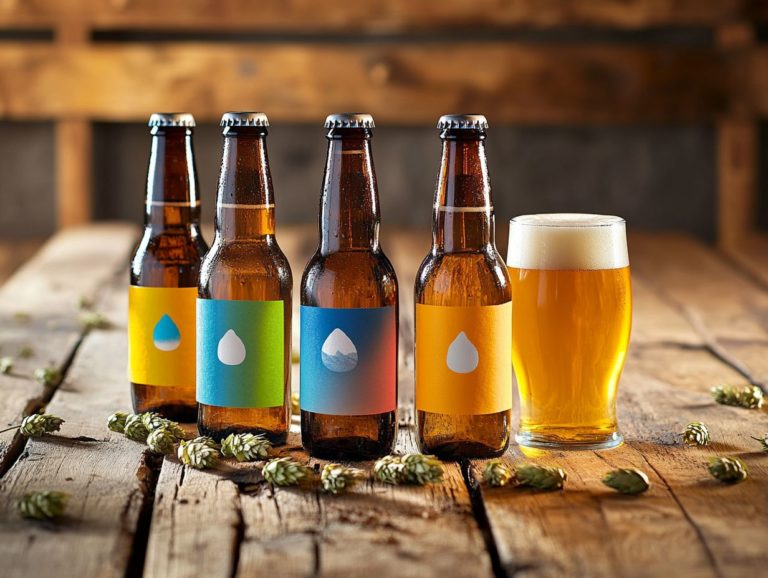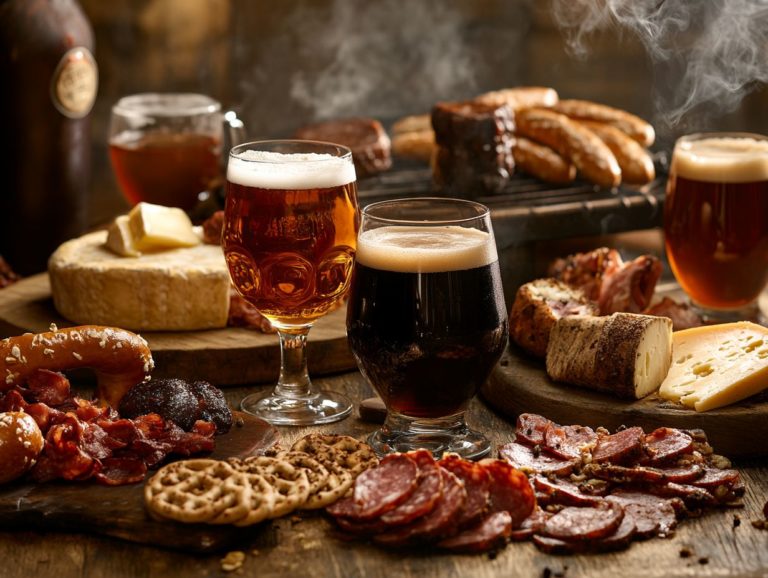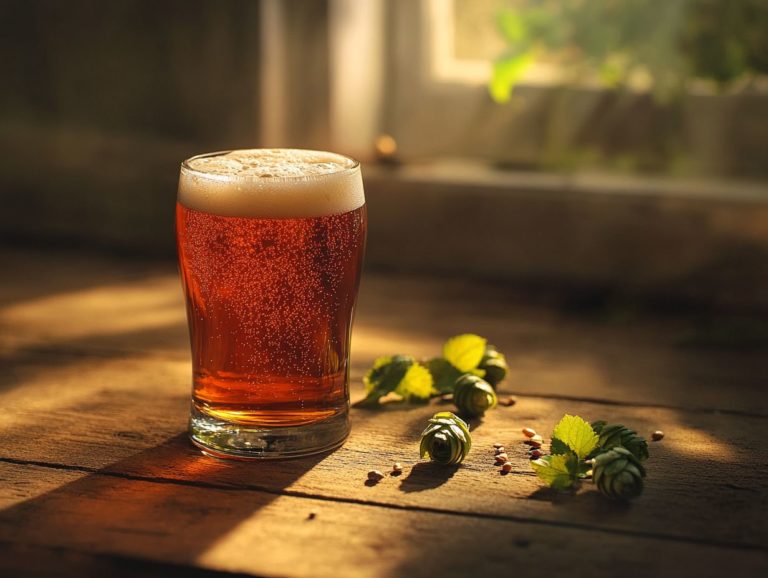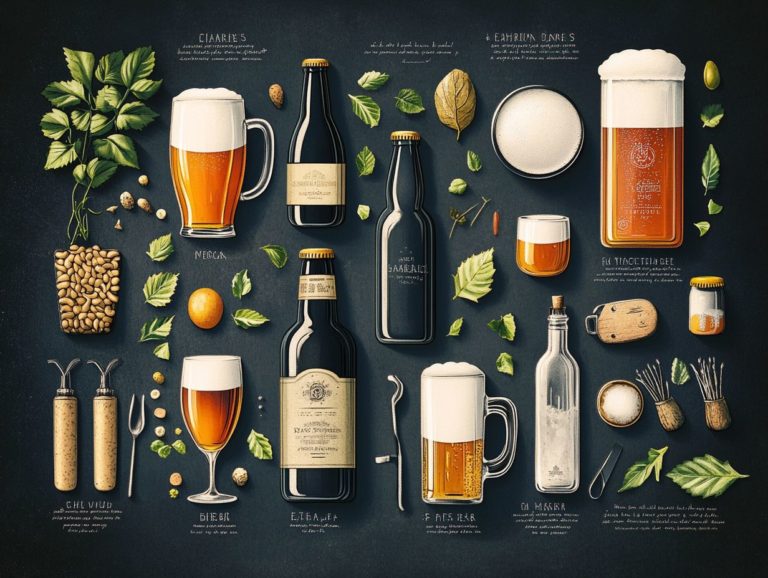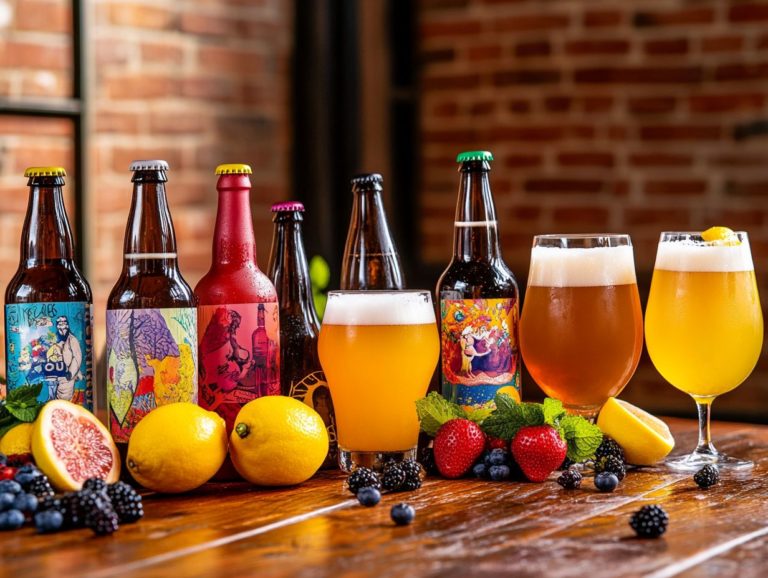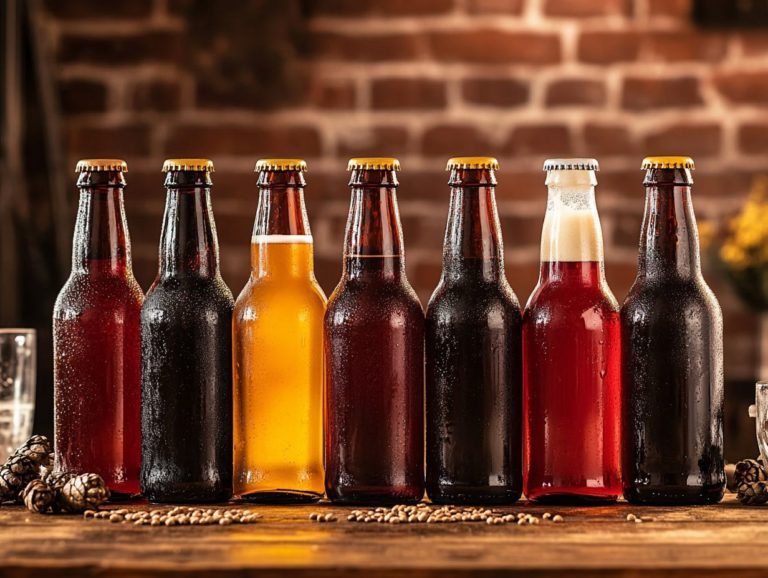The Importance of Yeast in Craft Beer Brewing
Ready to dive into the world of craft beer? Discover how yeast transforms simple ingredients into extraordinary brews!
Yeast is often the unsung hero of craft beer brewing, playing a pivotal role in fermentation and flavor development.
This article invites you to explore the fascinating world of yeast, delving into its biological makeup and integral function in crafting unique and flavorful beers. You will discover how different yeast strains influence taste, the crucial process of pitching yeast, and the factors that brewers must consider to achieve their desired results.
Join in as you uncover the importance of yeast in creating exceptional craft beers and look ahead to the innovations that are shaping its future.
Contents
- Key Takeaways:
- What is Yeast?
- The Role of Yeast in Brewing Beer
- The Importance of Choosing the Right Yeast for Brewing
- The Process of Adding Yeast to Beer
- What is Pitching Yeast?
- How is Yeast Added to Beer During the Brewing Process?
- The Importance of Controlling Yeast in Brewing
- What Factors Can Affect Yeast During the Fermentation Process?
- How Can Brewers Control Yeast to Achieve Desired Results?
- The Role of Yeast in Creating Unique and Flavorful Craft Beers
- The Future of Yeast in Craft Beer Brewing
- Frequently Asked Questions
- What is the role of yeast in craft beer brewing?
- Why is it important to use the right type of yeast in craft beer brewing?
- Can the quality of yeast affect the overall quality of the beer?
- How does temperature affect the performance of yeast in craft beer brewing?
- Are there different types of yeast used in craft beer brewing?
- Can using naturally occurring yeast found in the environment result in unique flavors in craft beer?
Key Takeaways:
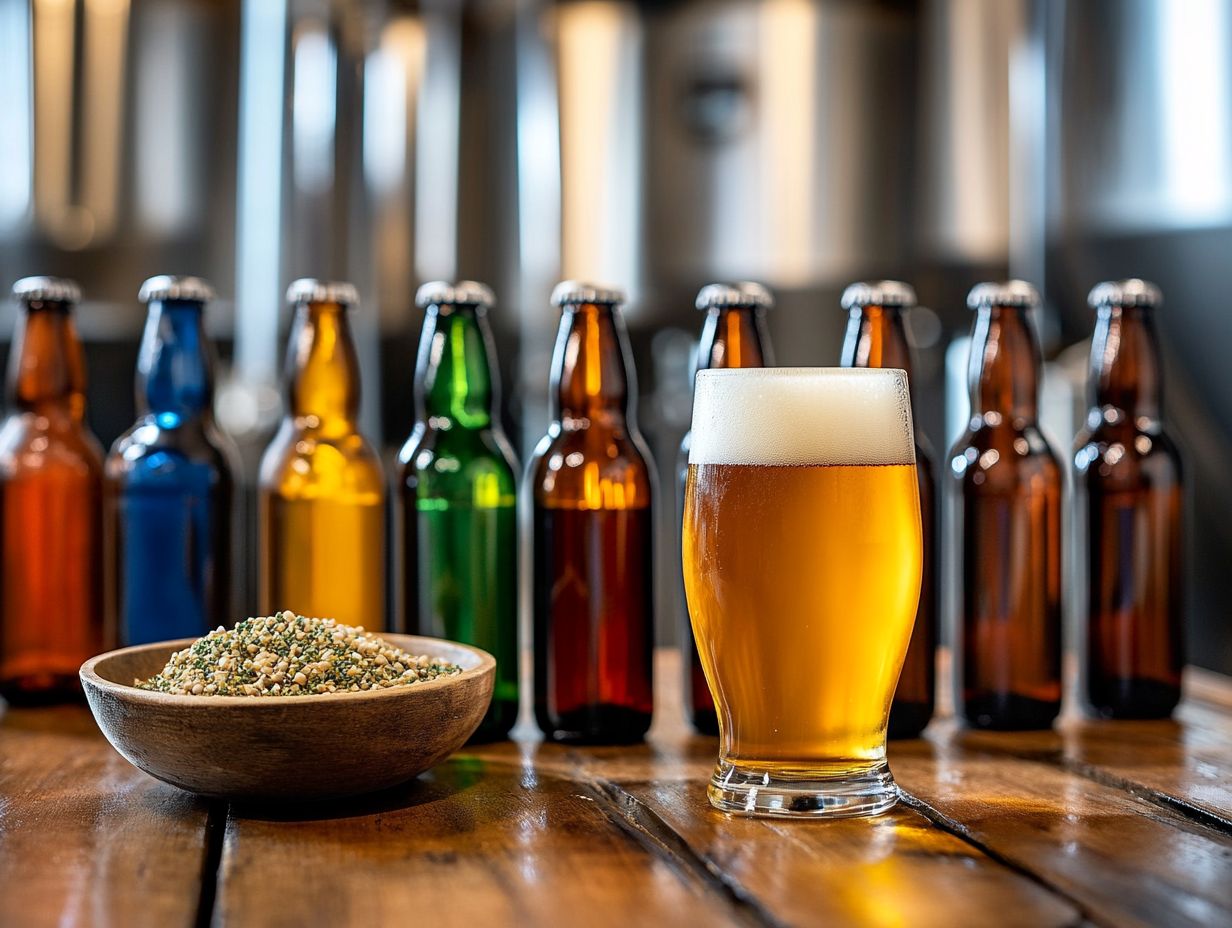
- Yeast is a crucial ingredient in craft beer brewing, responsible for the fermentation process that produces alcohol and unique flavors.
- Choosing the right yeast strain is essential for creating a desired beer flavor, and factors such as temperature and wort composition must be considered.
- Brewers have the ability to control yeast to achieve desired results, and using different yeast strains can lead to the creation of unique and flavorful craft beers.
What is Yeast?
Yeast serves as a pivotal microorganism in a myriad of fermentation processes, especially in the brewing industry, where it plays an essential role in crafting alcoholic beverages like beer.
You will find that the most prevalent yeast strains in brewing belong to the Saccharomyces genus, with Saccharomyces cerevisiae and Saccharomyces pastorianus being the primary species utilized to transform wort into beer. These minuscule organisms are responsible for converting sugars into alcohol and carbon dioxide, while also imparting distinctive flavors and aromas that characterize various beer styles.
By grasping the biological traits of yeast and its applications, you will gain a deeper mastery of brewing techniques and elevate the overall quality of your craft beers.
The Role of Yeast in Brewing Beer
Yeast plays an essential role in brewing beer, acting as the essential agent responsible for fermentation, where the sugars from wort are transformed into alcohol and carbon dioxide. This intricate process not only generates the desired alcohol content but also influences the flavors and aromas of the beer.
Your selection of yeast is crucial if you aim to craft unique beverages. The strain you choose be it ale yeast, lager yeast, or wild yeast directly affects the fermentation characteristics and the overall profile of your final product.
Understanding yeast’s roles can unlock exciting possibilities, allowing you to create extraordinary craft beers.
What is Fermentation?
Fermentation is a fascinating metabolic process where yeast works its magic, converting sugars into alcohol and carbon dioxide. This typically happens in an anaerobic environment during the brewing of beer. It s not just about creating alcoholic beverages; this chemical process is crucial for developing the diverse flavors and aromas that define different beer styles.
By mastering the art of fermentation, you can manipulate various parameters like temperature and duration to influence the production of fermentation by-products and ultimately shape the final taste and quality of your brew.
In essence, fermentation falls into two main categories: anaerobic and aerobic, each leaving its unique mark on the final product. Anaerobic fermentation, which takes place without oxygen, gives the power to yeast to produce ethanol while releasing carbon dioxide, which contributes to the delightful carbonation of your beer.
Conversely, aerobic fermentation introduces oxygen, enhancing yeast growth and metabolic activity, which can elevate specific flavor profiles. The choice of yeast strain you select also significantly impacts the outcome; different strains exhibit distinct behaviors under varying temperature conditions, resulting in diverse ester and phenol production.
Cooler temperatures often yield clean, crisp flavors, while warmer conditions may bring forward more vibrant fruity or spicy notes. This intricate interplay between fermentation dynamics and the artistry of brewing is what makes the process so captivating.
How Does Yeast Affect the Flavor of Beer?
Yeast plays a pivotal role in shaping the flavor profile of beer by generating a variety of fermentation by-products that enhance your overall tasting experience. Depending on the yeast strain you choose like Saccharomyces cerevisiae or Saccharomyces pastorianus you can expect distinct flavor nuances during fermentation.
These can range from delightful fruity esters to intriguing spicy phenols, all influenced by the fermentation conditions and brewing techniques you employ. The intricate relationship between yeast metabolism, fermentation temperature, and the chemical composition of the wort culminates in a remarkable diversity of taste sensations in craft beers, underscoring the importance of selecting the right yeast to achieve your desired flavor outcomes.
For instance, fermenting at higher temperatures with ale yeasts tends to produce more fruity esters, imparting flavors reminiscent of banana and clove especially beloved in styles like Hefeweizen. On the other hand, lager yeasts thrive at cooler temperatures, resulting in a cleaner, crisper taste with subtle malt notes, as seen in a classic Pilsner.
Certain strains may also yield higher levels of phenols, introducing unique flavors such as smokiness or spiciness that can elevate the beer’s profile to new heights. This subtle interplay of fermentation by-products not only enriches the complexity of craft beers but also invites you to explore and experiment creatively throughout the brewing process.
What Types of Yeast are Used in Brewing Craft Beer?
The world of craft beer brewing offers a rich tapestry of yeast varieties, with three main categories standing out: ale yeast, lager yeast, and wild yeast. Each type brings its own unique flair to the final creation, allowing you to explore a vast array of flavors and styles.
If you’re leaning toward bold styles like IPAs and stouts, ale yeast is your go-to. It thrives in a temperature range of 60-75 F, promoting vigorous fermentation that generates those delightful esters and phenols, adding aromatic complexity to your brew.
On the flip side, if you appreciate a crisp pilsner or a refreshing lager, you ll want to work with lager yeast, which excels at cooler temperatures of 45-55 F, resulting in a clean and refined taste.
For the adventurous brewer, wild yeast strains like Brettanomyces invite a touch of funkiness and depth, perfect for those diving into sour beers and barrel-aged creations. This remarkable diversity in yeast selection not only enriches the brewing process but also elevates your overall tasting experience, allowing you to savor the artistry behind each sip.
The Importance of Choosing the Right Yeast for Brewing
Selecting the right yeast for your brewing endeavors is essential, as it directly influences the fermentation process, flavor development, and the overall quality of your final product. Each yeast strain boasts unique fermentation characteristics that can affect not just the alcohol content and carbonation levels, but also the aroma and taste of your beer. Therefore, yeast selection is a pivotal consideration for any brewer.
You’ll want to consider factors such as the type of beer you re crafting, the flavors you wish to achieve, and the fermentation conditions you’re working with to ensure the chosen yeast aligns perfectly with your vision.
By grasping the specific attributes of various yeast strains, you can implement targeted brewing techniques that help you realize your desired outcomes with finesse.
How Does Yeast Strain Affect the Final Product?
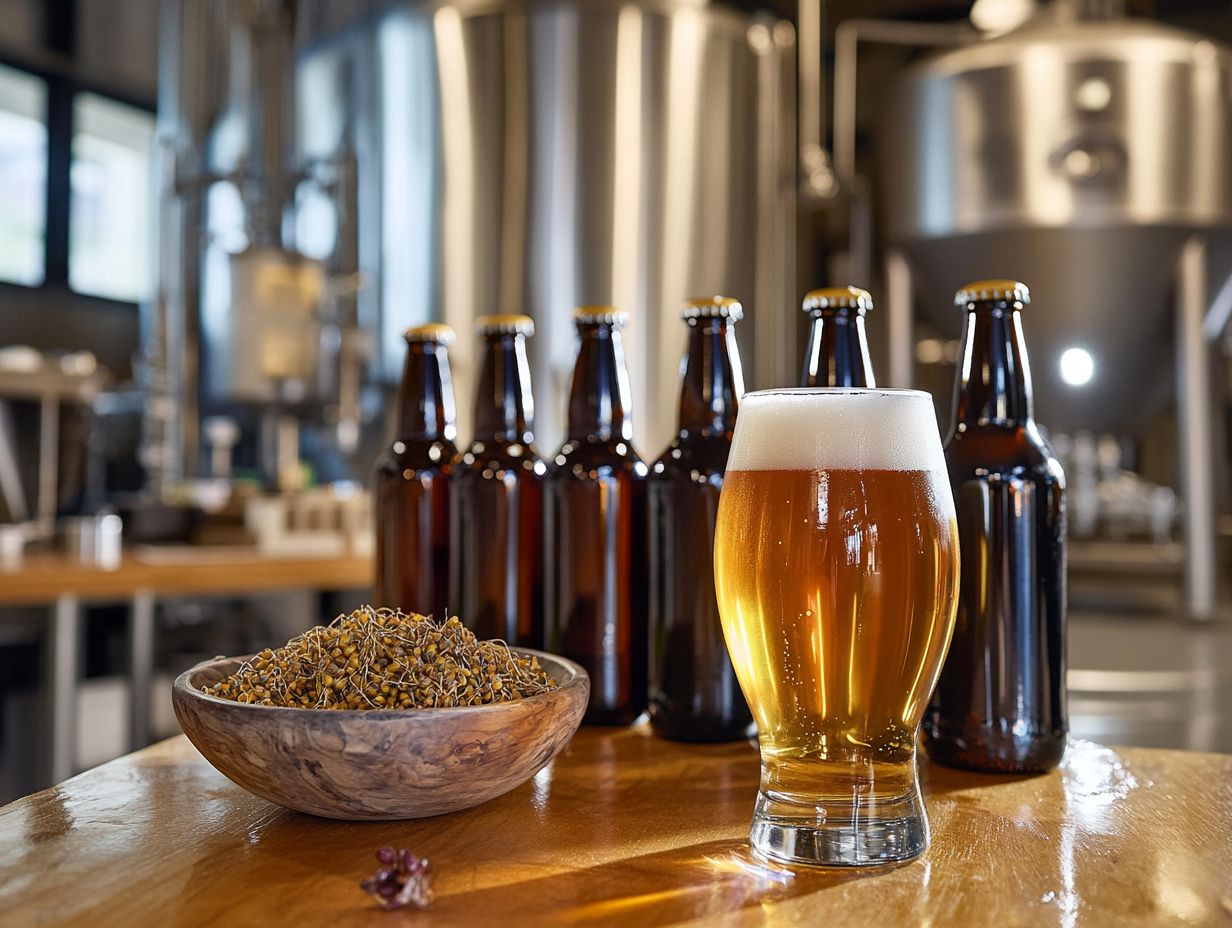
The choice of yeast strain profoundly impacts your final product in brewing. It influences not just the alcohol content and carbonation but also the flavor and aroma profiles of your beer.
Different yeast strains come with their own fermentation characteristics, such as temperature tolerance, fermentation speed, and the types of by-products they produce. All these factors shape the sensory experience of your finished beer.
Opting for ale yeasts will give you fruity esters. In contrast, lager yeasts will bring a cleaner taste to the table. This demonstrates how selecting the right yeast strain can enhance or complement specific brewing styles and objectives.
Specialized strains like Brettanomyces can infuse your beers with unique funky notes and complexity, especially in sour brews. On the other hand, champagne yeast is renowned for its knack for producing high levels of alcohol and natural carbonation, making it a favorite in sparkling wine production.
The efficiency of yeast during fermentation plays a significant role in your brewing operations. The strains you select can influence fermentation duration and attenuation rates, ultimately affecting your production timelines and costs.
Therefore, grasping these characteristics is essential for maintaining consistency and adhering to style guidelines. This makes yeast selection a pivotal element of your brewing process.
What Factors Should Be Considered When Choosing Yeast for Brewing?
When you re choosing yeast for brewing, there are several key factors to consider to ensure successful fermentation and achieve the flavor outcomes you desire. You’ll want to think about the type of beer you’re brewing, the fermentation temperature, the characteristics of the yeast strain, and the flavor profile you’re aiming for.
Evaluating yeast efficiency, propagation methods, and any historical context related to specific yeast strains will help you make informed decisions throughout the selection process. By carefully assessing these elements, you can optimize your brewing techniques and elevate the overall quality of your craft beers.
The yeast you select doesn t just influence primary fermentation; it also plays a critical role in shaping the final aroma and taste of your beer. For example, fermenting at high temperatures can ramp up ester and phenol production, significantly affecting the overall flavor.
On the flip side, lower fermentation temperatures typically yield a cleaner profile, often sought after in lagers. Don t forget to consider the specific attributes of different yeast strains, such as attenuation levels and flocculation, as these can significantly alter the mouthfeel and clarity of your beer.
As you embark on your brewing journey, it s essential to define your goals whether you re looking to capture the authenticity of a traditional style or exploring innovative flavors. This clarity empowers your yeast selection, ensuring each brew is an exciting adventure!
The Process of Adding Yeast to Beer
Adding yeast to beer known as pitching is a crucial step in brewing. It kicks off fermentation and transforms wort into a flavorful beer.
At this stage, you ll want to meticulously introduce the yeast into the cooled wort, creating the perfect environment for fermentation to take flight. Employing proper pitching techniques can significantly affect yeast performance, fermentation speed, and ultimately, the overall quality of your finished brew.
By grasping the essentials of pitching yeast and its integral role in the fermentation process, you can elevate your brewing skills and craft beers that truly reflect your desired flavors.
What is Pitching Yeast?
Pitching yeast is the art of introducing yeast culture to your wort (the liquid extracted from the malted grains), marking the critical moment when fermentation begins an essential step in the brewing journey.
This process involves adding a carefully measured amount of yeast to the cooled wort, creating the right conditions for the yeast to grow as it transforms sugars into alcohol and carbon dioxide.
The timing, temperature, and method you choose for pitching yeast can significantly influence both the fermentation process and the flavors that emerge in your final beer. Grasping the intricacies of pitching yeast is vital for any brewer looking to create specific flavor profiles and achieve outstanding fermentation results.
For optimal yeast inoculation, aim to cool your wort to around 65 F to 75 F, as this temperature range is ideal for most ale yeasts. It s equally important to pitch the right amount of yeast generally between 0.5 to 1 million cells per milliliter per degree Plato of wort ensuring you have a robust yeast density to ferment effectively.
Consider techniques like rehydration or direct pitching from a starter, as these methods can boost yeast health and viability. By maintaining optimal conditions throughout the fermentation process, you not only encourage vigorous fermentation but also minimize the risk of off-flavors, resulting in a cleaner, more enjoyable final product.
How is Yeast Added to Beer During the Brewing Process?
During the brewing process, you ll introduce yeast to your beer through a method known as pitching. This happens after the wort has been boiled, cooled, and aerated. It s a crucial step where you add the yeast to the prepared wort, ensuring it s evenly distributed for optimal fermentation.
You have various pitching methods at your disposal, such as dry pitching, where you sprinkle dry yeast directly onto the wort, or re-hydration techniques that prep the yeast for fermentation. The method you choose can significantly influence the efficiency and effectiveness of the fermentation process, ultimately shaping the flavors and aromas of your finished beer.
Effective yeast management practices, like monitoring temperature and the acidity of the liquid, are vital to ensuring fermentation success. For example, employing a yeast starter can boost the cell count, leading to more vigorous fermentation, while techniques like gentle stirring or aeration can help maintain sufficient oxygen levels during the initial stages.
Each pitching technique offers unique advantages and can result in distinct flavor profiles, allowing you to customize your beer to match specific preferences. Therefore, grasping these methods is essential for achieving the perfect balance of taste and aroma in your final product.
The Importance of Controlling Yeast in Brewing
Controlling yeast in brewing is crucial for achieving consistent results during fermentation, as it profoundly influences the quality, flavor, and overall success of your beer.
You need to meticulously monitor and adjust factors such as temperature, pH, oxygen levels, and nutrient availability throughout the fermentation process to promote healthy yeast activity and avert undesirable outcomes, like off-flavors or stuck fermentation.
Your ability to manage these variables not only guarantees optimal yeast performance but also gives you the power to create unique, high-quality craft beers that truly embody your brewing vision.
By mastering these techniques, you can elevate your brewing game and craft exceptional beers that reflect your unique style.
What Factors Can Affect Yeast During the Fermentation Process?
Several factors can profoundly impact yeast during the fermentation process, shaping its performance and the quality of your final beer. Temperature is one of the most critical variables. It dictates yeast activity and fermentation speed. If the temperature swings too high or too low, you risk undesirable flavors or even a stalled fermentation.
The availability of oxygen, essential nutrients, and overall brewing conditions are vital in supporting yeast health and activity. By understanding these factors, you can fine-tune your fermentation process to craft consistently high-quality beers.
Pay meticulous attention to temperature management, ideally keeping it within the optimal ranges for the specific yeast strain you are using. For example, ale yeasts typically flourish at warmer temperatures compared to lager yeasts, leading to distinctly different flavor profiles.
Oxygen levels are equally important. While you need a small amount at the start for yeast growth, too much oxygen can lead to oxidation, a process that can spoil beer flavor, compromising freshness and taste. Nutrient availability, encompassing primary nutrients like nitrogen and trace minerals, must be precisely balanced to ensure that your yeast remains healthy and active throughout fermentation.
This comprehensive approach to managing fermentation parameters directly correlates with the richness, complexity, and overall quality of your final product.
How Can Brewers Control Yeast to Achieve Desired Results?
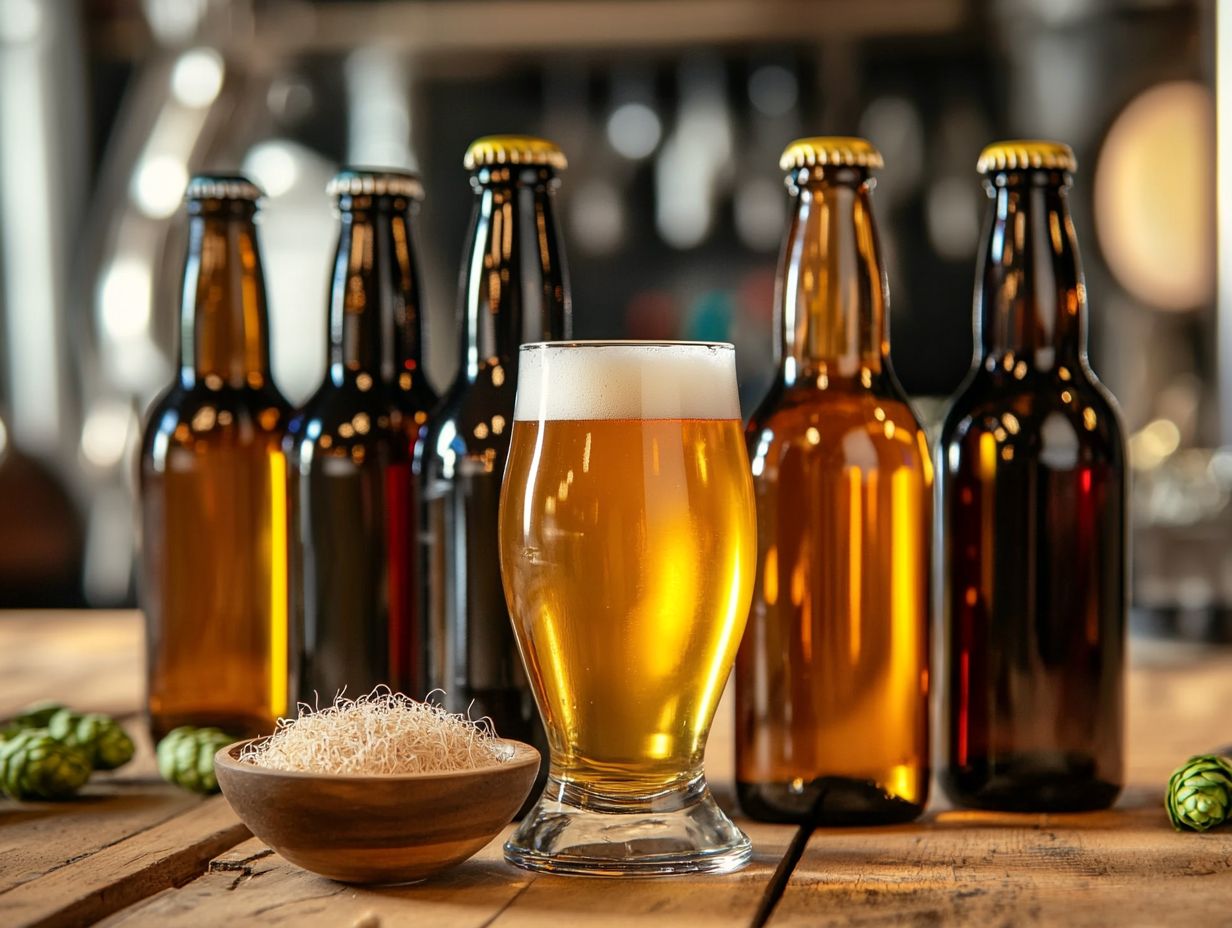
As a brewer, you can control yeast and achieve your desired results through meticulous management of fermentation conditions and the application of specific brewing techniques. By skillfully regulating temperature, ensuring proper oxygenation, and providing the right nutrients, you can foster healthy yeast activity and enhance fermentation efficiency.
Understanding the unique properties of different yeast strains allows you to tailor your techniques to optimize flavor production and fermentation outcomes, ultimately crafting high-quality beer that aligns with your vision. This level of control is essential for achieving consistency and excellence in the brewing process.
Temperature control is critical; maintaining the optimal range for your chosen yeast strain can prevent off-flavors and promote the desirable esters and phenols that elevate your brew.
Oxygenation at the right stages encourages yeast health and vigor, especially during the initial phases of fermentation. Supplementing with nutrients like amino acids and vitamins further boosts yeast performance, ensuring a healthy and active fermentation process.
When you thoughtfully combine these methods, you can achieve the precise flavor profiles you aspire to, resulting in brews that are both consistent and flavorful. Take control of your fermentation process today!
The Role of Yeast in Creating Unique and Flavorful Craft Beers
Yeast plays a crucial role in crafting unique and flavorful craft beers, acting as the catalyst for both fermentation and flavor development. Different yeast strains can impart distinct characteristics to your beer, influencing its aroma, taste, and overall mouthfeel.
For instance, some strains might produce fruity esters or spicy phenols, while wild yeast varieties can introduce complex flavors that elevate craft beers above their mass-produced counterparts.
By experimenting with various yeast strains and fermentation techniques, you can push the boundaries of flavor and create truly exceptional beers that showcase your artistry and creativity.
How Can Brewers Use Different Yeast Strains to Create Unique Beers?
You can harness the incredible power of different yeast strains to create unique beers. Understand how yeast behaves during fermentation and the flavor contributions of each strain.
By selecting specific yeast strains, you can manipulate fermentation conditions. This enhances desired flavors or even introduces unexpected taste profiles.
For instance, opting for a Kveik strain, a traditional Norwegian yeast, can yield delightful fruity and tropical notes. Traditional ale or lager yeasts provide classic flavors you might crave.
This strategic use of yeast, combined with innovative fermentation techniques, allows you to craft beers that challenge conventions and delight consumers.
The fascinating world of brewing is enriched by various yeast strains, each offering a distinct palette of flavors that can elevate your final product.
Take, for example, Belgian yeast strains, renowned for their spicy and estery profiles, which truly shine in styles like Triples and Dubbels. Conversely, using American ale yeast can lead to crisp and clean beers, perfect for styles such as Pale Ales or IPAs.
By adjusting fermentation temperatures or oxygen levels, you can influence the yeast’s behavior. This allows for deeper complexity or a more subdued profile.
In brewing, it s not only the type of yeast you select that matters; it s also how you harness it throughout the brewing process that makes all the difference.
What are Some Examples of Craft Beers That Showcase the Importance of Yeast?
Numerous craft beers showcase the vital role of yeast in flavor development and overall quality, revealing the remarkable spectrum of flavors that can be achieved through careful yeast selection.
Take Orval, for instance a Trappist ale that employs Brettanomyces yeast to deliver earthy, funky qualities, transforming each sip into a delightful journey of taste.
Similarly, when you indulge in German wheat beers, you ll often encounter Hefeweizen yeasts that conjure distinctive notes of banana and clove, resulting in a refreshing profile that is both rich and aromatic.
Innovative techniques like varying fermentation temperatures or utilizing mixed fermentation methods can elevate the character of the beer even further. This creativity exemplifies how brewers leverage the natural properties of yeast to push boundaries, crafting exciting new offerings that reflect their unique interpretations of traditional styles.
The Future of Yeast in Craft Beer Brewing
The future of yeast in craft beer brewing is about to experience thrilling advancements, with continuous innovations in yeast strains and fermentation techniques that are set to transform the brewing landscape.
As you delve into the genetic diversity of yeast and its myriad applications, you’ll encounter new strains being uncovered that can elevate flavor profiles, enhance fermentation efficiency, and even support sustainable brewing practices.
These breakthroughs empower you, as a brewer, to create distinctive and high-quality beers now more than ever! Additionally, they cultivate a richer understanding of yeast’s vital role in the brewing process, paving the way for the next wave of craft beer innovation.
What Innovations Are Being Made in Yeast Strains for Brewing?
Innovations in yeast strains for brewing are leading the charge in the craft beer revolution, inviting you to explore the intricate genetic makeup of yeast and discover new strains that elevate flavor profiles and fermentation efficiency. Advances in brewing science have made it possible to identify and isolate yeast strains with unique fermentation characteristics, such as enhanced temperature tolerance or the ability to produce distinct flavor compounds.
These innovations equip you with fresh tools for crafting exceptional beers, inspiring experimentation and creativity within the brewing community.
With the advent of CRISPR technology and other genetic engineering techniques, you can now fine-tune yeast strains to create bespoke flavors that align beautifully with various beer styles. For example, some strains are purposefully modified to amplify the production of fruity esters, which can significantly elevate IPAs or Belgian-style ales. This newfound adaptability offers a spectrum of flavor profiles that were once beyond reach, pushing the limits of traditional brewing.
These advancements also bolster fermentation efficiency, minimizing the time and resources needed to produce high-quality beer while ensuring consistent results across different batches. This is a win-win for both craft breweries and larger operations, allowing you to enjoy the fruits of innovation in every sip.
How Can Yeast Play a Role in Sustainable Brewing Practices?
Yeast plays a pivotal role in sustainable brewing practices, significantly enhancing energy-efficient fermentation processes and minimizing waste in brewing operations. By carefully selecting yeast strains that exhibit higher fermentation efficiency, you can reduce resource consumption while improving the overall sustainability of your production methods.
Embracing innovative practices such as reusing yeast cultures and experimenting with wild yeast fermentation can elevate your brewing process and promote environmental responsibility. As the craft beer industry continues to flourish, integrating sustainable practices involving yeast becomes essential for making a positive impact on both the environment and the quality of the beer you produce.
For instance, consider breweries that implement closed fermentation systems, capturing carbon dioxide generated during fermentation for reuse, thereby minimizing their carbon footprint. Trailblazers like Sierra Nevada and Dogfish Head have adopted methods to harvest and recycle yeast, allowing them to maintain vibrant and diverse flavors in their beers while significantly reducing waste.
These initiatives not only showcase a commitment to sustainability but also reinforce the notion that efficient yeast management can lead to exceptional flavor profiles, ultimately satisfying consumers who are increasingly mindful of their environmental impact.
Frequently Asked Questions
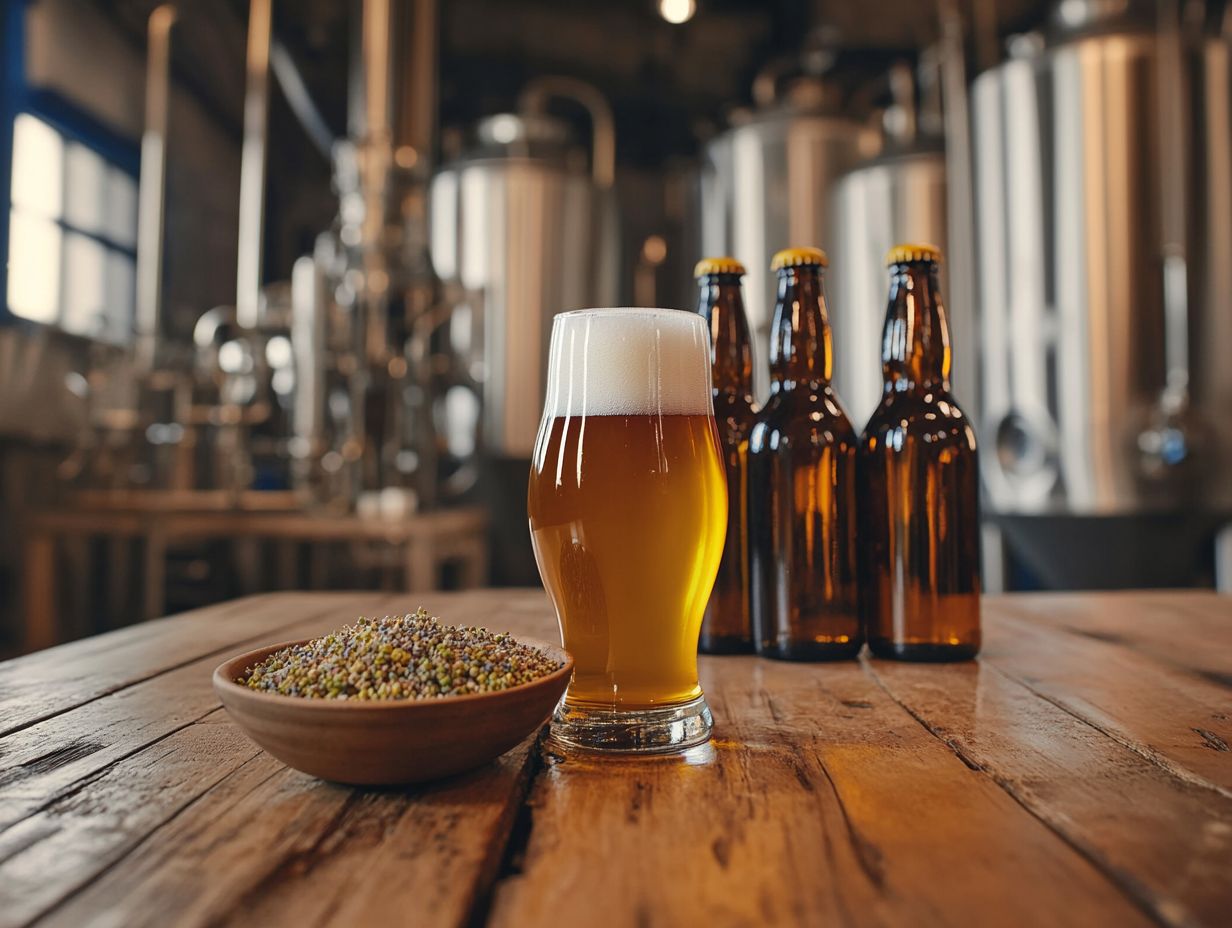
What is the role of yeast in craft beer brewing?
Yeast is responsible for converting the sugars in the wort into alcohol and carbon dioxide, creating the desired alcohol content and carbonation in the final product.
Why is it important to use the right type of yeast in craft beer brewing?
The type of yeast used can greatly impact the flavor and aroma of the beer. Different strains of yeast produce different flavors and can contribute to the complexity of the beer.
Can the quality of yeast affect the overall quality of the beer?
Absolutely. The health and vitality of the yeast used can greatly impact the fermentation process and ultimately the flavor and quality of the beer.
How does temperature affect the performance of yeast in craft beer brewing?
Yeast performs best within a certain temperature range, and variations in temperature can greatly affect its ability to ferment and produce flavors. It’s important to carefully control the temperature during fermentation for optimal results.
Are there different types of yeast used in craft beer brewing?
Yes, there are two main types of yeast used in craft beer brewing: ale yeast and lager yeast. The type of yeast used depends on the desired style of beer and the brewing process.
Can using naturally occurring yeast found in the environment result in unique flavors in craft beer?
Yes, craft brewers often use naturally occurring yeast found in the environment to create exciting and complex flavors in their beer.
This technique is particularly popular in sour or farmhouse-style beers.

